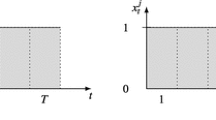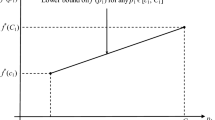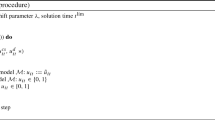Abstract
We present a unit commitment model which determines generator schedules, associated production and storage quantities, and spinning reserve requirements. Our model minimizes fixed costs, fuel costs, shortage costs, and emissions costs. A constraint set balances the load, imposes requirements on the way in which generators and storage devices operate, and tracks reserve requirements. We capture cost functions with piecewise-linear and (concave) nonlinear constructs. We strengthen the formulation via cut addition. We then describe an underestimation approach to obtain an initial feasible solution to our model. Finally, we constitute a Benders’ master problem from the scheduling variables and a subset of those variables associated with the nonlinear constructs; the subproblem contains the storage and reserve requirement quantities, and power from generators with convex (linear) emissions curves. We demonstrate that our strengthening techniques and Benders’ Decomposition approach solve our mixed integer, nonlinear version of the unit commitment model more quickly than standard global optimization algorithms. We present numerical results based on a subset of the Colorado power system that provide insights regarding storage, renewable generators, and emissions.




Similar content being viewed by others
References
Bouffard, F., & Galiana, F. (2008). Stochastic security for operations planning with significant wind power generation. IEEE Transactions on Power Systems, 23(2), 306–316. doi:10.1109/TPWRS.2008.919318.
Brooke, A., Kendrick, D., Meeraus, A., & Rosenthal, R. (1988). GAMS, a user’s guide. Scientific Press.
Bussieck, M. R., & Meeraus, A. (2004). General algebraic modeling system (GAMS). In J. Kallrath (Ed.), Modeling languages in mathematical optimization (pp. 137–157). Norwell: Kluwer Academic.
Dillon, T., Edwin, K., Kochs, H., & Taud, R. (1978). Integer programming approach to the problem of optimal unit commitment with probabilistic reserve determination. IEEE Transactions on Power Apparatus and Systems, 97(6), 2154–2166.
Duran, M., & Grossmann, I. (1986). An outer-approximation algorithm for a class of mixed-integer nonlinear programs. Mathematical Programming, 36, 307–339. doi:10.1007/BF02592064.
Exarchakos, L., Leach, M., & Exarchakos, G. (2009). Modelling electricity storage systems management under the influence of demand-side management programmes. International Journal of Energy Research, 33(1), 62–76. doi:10.1002/er.1473.
Gollmer, R., Nowak, M., Römisch, W., & Schultz, R. (2000). Unit commitment in power generation—a basic model and some extensions. Annals of Operations Research, 96, 167–189. doi:10.1023/A:1018947401538.
IBM (2011). IBM ILOG GAMS version 12.3 user’s guide: standard (command-line) version including CPLEX directives, Incline village, NV.
Lahdelma, R., & Ruuth, S. (1994). A modified Benders’ decomposition technique for solving large scale unit commitment problems. In J. Henry & J. P. Yvon (Eds.), Lecture notes in control and information sciences: Vol. 197. System modelling and optimization (pp. 737–745). Berlin: Springer. doi:10.1007/BFb0035523.
Lu, B., & Shahidehpour, M. (2005). Unit commitment with flexible generating units. IEEE Transactions on Power Systems, 20(2), 1022–1034 doi:10.1109/TPWRS.2004.840411.
Ma, H., & Shahidehpour, S. (1999). Unit commitment with transmission security and voltage constraints. IEEE Transactions on Power Systems, 14(2), 757–764 doi:10.1109/59.761909.
Moya, O. (2005). A spinning reserve, load shedding, and economic dispatch solution by Bender’s decomposition. IEEE Transactions on Power Systems, 20(1), 384–388. doi:10.1109/TPWRS.2004.831675.
Murtagh, B., Saunders, M., Murray, W., & Gill, P. (2011). Minos. version, 5, 51 user’s guide, GAMS.
National Renewable Energy Laboratory (2005). Generator, load and CEMS data. http://www.epa.gov/ttn/emc/cem.html.
Niknam, T., Khodaei, A., & Fallahi, F. (2009). A new decomposition approach for the thermal unit commitment problem. Applied Energy, 86(9), 1667–1674.
Padhy, N. (2004). Unit commitment-a bibliographical survey. IEEE Transactions on Power Systems, 19(2), 1196–1205. doi:10.1109/TPWRS.2003.821611.
Rahimi, S., Niknam, T., & Fallahi, F. (2009). A new approach based on Benders Decomposition for unit commitment problem. World Applied Sciences Journal, 6(12), 1665–1672.
Rebours, Y., & Kirschen, D. (2005). What is spinning reserve? Tech. Rep. Release 1, University of Manchester.
Saharidis, G. K., & Ierapetritou, M. G. (2010). Improving Benders decomposition using maximum feasible subsystem (MFS) cut generation strategy. Computers & Chemical Engineering, 34(8), 1237–1245. doi:10.1016/j.compchemeng.2009.10.002.
Saharidis, G. K., Boile, M., & Theofanis, S. (2011). Initialization of the Benders master problem using valid inequalities applied to fixed-charge network problems. Expert Systems with Applications, 38(6), 6627–6636. doi:10.1016/j.eswa.2010.11.075.
Sioshansi, R. (2010). Evaluating the impacts of real-time pricing on the cost and value of wind generation. IEEE Transactions on Power Systems, 25(2), 741–748. doi:10.1007/s10479-012-1102-9.
Sioshansi, R., Denholm, P., Jenkin, T., & Weiss, J. (2009). Estimating the value of electricity storage in PJM: Arbitrage and some welfare effects. Energy Economics, 31(2), 269–277. doi:10.1016/j.eneco.2008.10.005.
Takriti, S., Krasenbrink, B., & Wu, L. S. Y. (2000). Incorporating fuel constraints and electricity spot prices into the stochastic unit commitment problem. Operations Research, 48(2), 268.
Tawarmalani, M., & Sahinidis, N. (2004). Global optimization of mixed-integer nonlinear programs: A theoretical and computational study. Mathematical Programming, 99, 563–591.
Tuohy, A., Meibom, P., Denny, E., & O’Malley, M. (2008). Benefits of stochastic scheduling for power systems with significant installed wind power. In Proceedings of the 10th international conference on probabilistic methods applied to power systems, 2008. PMAPS’08 (pp. 1–7).
Tuohy, A., Meibom, P., Denny, E., & O’Malley, M. (2009). Unit commitment for systems with significant wind penetration. IEEE Transactions on Power Systems, 24(2), 592–601. doi:10.1109/TPWRS.2009.2016470.
Wang, J., Shahidehpour, M., & Li, Z. (2008). Security-constrained unit commitment with volatile wind power generation. IEEE Transactions on Power Systems, 23(3), 1319–1327. doi:10.1109/TPWRS.2008.926719.
Westerlund, T., & Lastusilta, T. (2011). AlphaECP version 2.04.02 user’s guide, GAMS.
Wu, L., & Shahidehpour, M. (2010). Accelerating the Benders decomposition for network-constrained unit commitment problems. Energy Systems, 1, 339–376. doi:10.1007/s12667-010-0015-4.
Acknowledgements
We acknowledge the following people who have assisted significantly in this research. James Milford of the National Renewable Energy Lab (NREL) introduced us to this problem. Dr. Greg Brinkman, also of NREL, provided guidance regarding data collection and analysis. Dónal O’Sullivan of the Colorado School of Mines helped with the initial coding efforts. Ryan Bracken and Maureen McDaniel, also of the Colorado School of Mines, gathered and cleaned data. Professor Luis Tenorio of the Colorado School of Mines provided suggestions for categorizing the intervals of the heat input curves. Dr. Sven Leyffer of Argonne National Labs provided general nonlinear programming recommendations. Jennifer Van Dinter was generously supported by NREL grant number KXEA-3-33607-53.
Author information
Authors and Affiliations
Corresponding author
Rights and permissions
About this article
Cite this article
Van Dinter, J., Rebennack, S., Kallrath, J. et al. The unit commitment model with concave emissions costs: a hybrid Benders’ Decomposition with nonconvex master problems. Ann Oper Res 210, 361–386 (2013). https://doi.org/10.1007/s10479-012-1102-9
Published:
Issue Date:
DOI: https://doi.org/10.1007/s10479-012-1102-9




